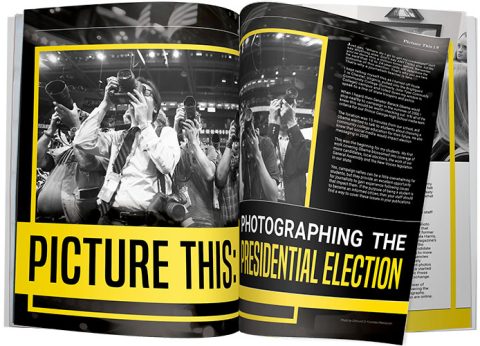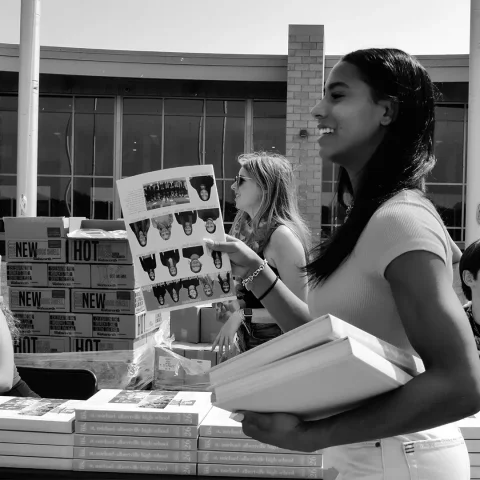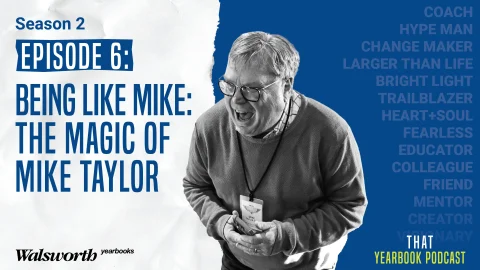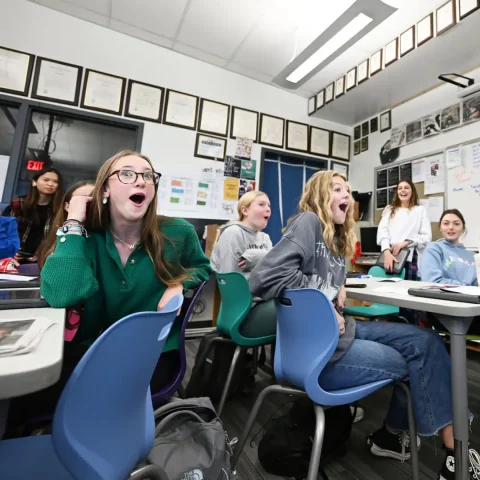Just say, “Where do I go to get my credentials?” Don’t say anything else. Don’t say ANYTHING else. Act like you’ve done this a million times before. Remember, he said that 18 to 24-year-olds will determine the outcome of this election. That’s why you are here. That’s why a journalism teacher is here.
I kept telling myself this as I turned off Route 1 in Chester, Virginia, pulled into the Brightpoint Community College (formerly John Tyler Community College) campus and rolled down my window to speak to a line of state troopers and police.
When I heard then-Senator Barack Obama would stop nearby to campaign in the summer of 2008, I knew this would be worth checking out. It fit all of the criteria for our Prince George High School media team.
The location was 15 minutes from our school, and Obama wanted to talk to students about choosing a community college education for their future. He also knew that social media would impact election messaging in 2008.
This was the beginning for my students. My first work covering Obama blossomed into coverage of more candidates, local elections, the work of our General Assembly and the New Voices legislation in our state.
Yes, campaign rallies can be a little overwhelming for students, but they provide an excellent opportunity for journalists to gain experience following issues that impact them. If the purpose of being a student is to become an informed citizen, then your staff should find a way to cover these issues in your publications.
DO WE BELONG?
First and foremost, yes.
Student journalists are journalists. They may be learning on the job, but they are still journalists. This point has been reinforced time and time again.
Students have the same rights as journalists who are paid to report on these events. Students who attend and take photos of the events own the rights to those photos. You can use those photos in your yearbook or publication just as you would with any student activity.
The process for acquiring press credentials is the same. In most cases, if you are covering a rally sponsored by a candidate, you obtain your press credentials through the campaign’s website. Unfortunately, this sometimes requires you to sign up for emails and announcements, which will flood your inbox.
When an event is about to occur – and it can be on very short notice – you must fill in the media credentials form online. This requires you to input your name, contact information, publication, editor/supervisor, position and your reason for coverage.
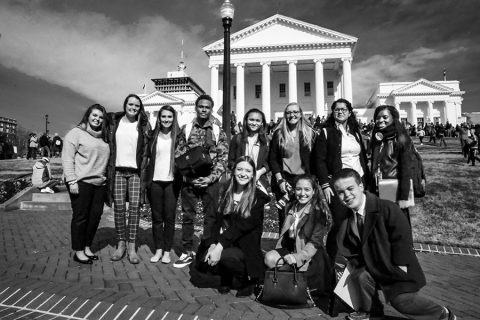
WHAT SHOULD WE DO WHEN WE GET THERE?
Most political events are set up the same way now. Here are some things your students can expect.
Before the event, the reporter should receive an email saying whether or not they have press credentials to cover it. Encourage your students to print this email and bring it to the event, along with a driver’s license or school ID and their press pass.
Most events will have two arrival times for the press, and both are really early. If your team is bringing a video camera and tripod that requires space, look for the media drop arrival time. This could be three to four hours before the event and may require you to leave your equipment and return later. This allows security to check your equipment for anything that could be dangerous. If you are just bringing a camera for still photography, you can arrive when media is allowed to enter.
The media will always have a second media-only entrance separate from the public. The general public is not allowed to enter here.
Once inside the event, there are usually three areas for media (this is where your students will be). A riser is usually located in the back, directly across from the stage and podium. This riser is typically full of national and local affiliates. Finding space here is challenging. Most of it is marked off with tape for the biggest mainstream media outlets. The second riser is usually on the side, with more space for still photographers. It is typically a good distance from the stage but not as far as the main riser.
WHAT IF WE CAN’T GET THERE?
During the 2008, 2012, 2016 and 2020 campaigns, my students were very fortunate because both parties felt our state was in play, meaning candidates would likely visit to try to turn the purple state red or blue. But what should you do if no one comes to your backyard because it consistently votes one way?
There are resources available for your journalism staff to use for coverage.
If you locate a photo on a government site, that photo is owned by you, the taxpayer. Since you paid for that photo, feel free to use images from a .gov site of former President Donald Trump or Vice President Kamala Harris, the presumptive Democratic candidate at this magazine’s time of publication, from their time in office. Both the Republican candidate and likely Democratic candidate have been in office in the White House, leading to more available photos for you. Many government agencies have user profiles on Flickr, where you can freely download photos for your own use. If you want photos of candidates at rallies, check out the resource started by some advisers with the National Scholastic Press Association (NSPA) and the Campaign 2020 Photo Exchange.
This is also a great opportunity to use the power of social media to reach out to other staffs covering the campaigns to see if you can use their photography. JEADigitalMedia.org has a list of staffs who are online.
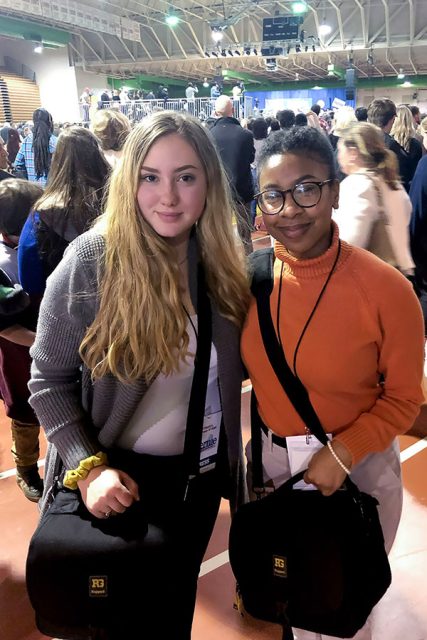
WHAT SHOULD WE DO NOW?
The election is just a few short months away, so plan now.
First, find out who on your staff is interested in following this topic. If you don’t have someone invested on staff, maybe you can ask some of your history and government teachers if they know of any top students who would want to help out.
Like any other story or topic, after you assign reporters, develop a plan for coverage, layout and publication. Have a list of contacts and websites that your reporters and editors can contact now to plan for the end of summer and fall.
Reach out to the local offices of your state senators and members of Congress to see if you can interview them early. Once you have local contacts, they can assist you when the national candidates visit.
HOW DO WE STAY OBJECTIVE? HOW DO WE STAY SAFE?
One of the biggest concerns that our staff always has at the forefront of our discussion is how to cover both parties.
Once we covered President Obama, we immediately kept our eye on Senator McCain’s group in 2008 and Senator Romney’s group in 2012. We were able to attend events for both of them and also for Vice President Mike Pence. It was important for our reporters to show our community that we were covering both sides of the election.
The media is often mistrusted in today’s political climate because the public believes journalists fail to listen to their concerns. Challenging conspiracies or unsupported claims is okay, but as a journalist, it is important to still listen to the person you are interviewing. If you ask informed questions, you will hopefully get informed responses.
Just remember, you are in the business of journalism, and the candidates you cover are in the business of public relations.
If you can cover the voter rather than the candidate, it generally helps in many ways. How? Because the voter is local, part of your community and typically shares the same concerns as anyone who works and studies in your building. Find the local voter and talk to that person.
If you plan to cover anything where groups could be hostile towards people of different beliefs or the media covering the event, please keep these thoughts in mind. Students should never go to a rally alone. Always go with a friend, editor or adviser. I have had students who have been part of a media group jeered at for simply being reporters. It was important they knew they were not alone.
Above all, remember that this is a tough business. When you attend your first rally or publish your first spread on an election, give yourself room for growth and mistakes. You are covering history, and few people can say they have had the chance to report on a presidential election.
If you plan to take photos, here are a couple of suggestions:
- Bring a zoom lens (70-200 mm) and a wide-angle lens (15-30 mm)
or one with a wide range. You will need the 200 mm distance if you are on the riser. - Bring a small, one-step, foldable step stool. This will allow you to shoot above the crowd.
- Bring multiple SD cards and batteries. You never want to run out of storage or power on a long day.
- Never use flash. Security isn’t too kind to big distractions.
- Try to shoot in manual. The stage will have plenty of lights for the rest of the media, so you should be in good shape. A standard shutter speed setting of 1/125, aperture at f/3.5 and ISO on auto should work. If your f-stop can only go to f/5.6, you could set your ISO to a high number.
- Remember, your smartphone has a great camera too. Use your phone to get close-up shots of all that makes a rally visually appealing: signs, logos, crowds, etc.
- Bring business cards to hand out to anyone who wants to follow your coverage. You never know what kind of connection you might make.
- Avoid selfies. Remember, you are there to work. You are not there as a fan.

